News
On November 10, the second part of the Kickoff Meeting of the European PathoGelTrap project took place, a FET Open whose scientific coordination is carried out by the Laboratory of Dr. Mariano Carrión-Vázquez and which uses functional amyloids and other proteins forming biomolecular condensates to trap pathogens.
|
November 11, 2020
|
|
The project is coordinated by Mr. Enrique Amaré (CEO of SmartWater) and Dr. Mariano Carrión-Vázquez (Principal Investigator at Cajal Institute – CSIC). It was launched the 1st of June 2020, and will be working in the development of a dynamic tool using the current knowledge on the unique properties of proteins undergoing Liquid–Liquid Phase Separation (LLPS; a phenomenon also called biomolecular condensation), which eventually form hydrogels. The first steps will focus into performing rational design of a chimeric biomaterial linking a LLPS protein with an affibody, which is a small and robust protein able to bind target molecules (such as microbial antigens) with high affinity, imitating monoclonal antibodies. This biosensing material will be able to recognize and trap fish pathogens in different aquatic environments and conditions.
Follow the project at
https://pathogeltrap.eu/
|
The FET-OPEN project nanoBRIGHTH project enters in force
|
September 10, 2019
|
|
An ambitious international project involving the lab of Liset M de la Prida from the Instituto Cajal will use light to study and treat tumors, brain lesions and epilepsy, among other pathologies. The project looks to use photonic technologies in non-invasive interventions. NanoBright brin together a multidisciplinary team of physicists, nanotechnologists, neuroscientists and tumor biologists (Manuel Valiente lab at CNIO). The project is coordinated by the Istituto Italiano di Tecnologia (Italy), with the participation of the Pierre et Marie Curie University (France).
More information (in spanish): https://www.csic.es/es/actualidad-del-csic/un-proyecto-usara-la-luz-para-estudiar-y-tratar-tumores-y-lesiones-cerebrales
|
|
|
March 21, 2019
|
|
JLABS is a premier life science incubator program. JLABS is a global network of open innovation ecosystems, enabling and empowering innovators to create and accelerate the delivery of life-enhancing health and wellness solutions to patients around the world. As a leader in innovation, JLABS helps entrepreneurs in pharmaceutical, medical device, consumer, and health tech bring healthcare solutions to patients and consumers.
|
CA2 hippocampal region redefined.
|
February 12, 2019
|
|
A study led by Liset Menéndez de la Prida in collaboration which AixaV Morales, both from the Cajal Institute, has discovered how the CA2 region of the hippocampus is organized.
The work, published in the prestigious journal Cell Reports, shows that the pyramidal neurons of the CA2 region are distributed proximodistally around the end of the mossy fibers. The study has been featured on the cover of Cell Reports.
More information:
https://www.cell.com/cell-reports/fulltext/S2211-1247(19)30089-0
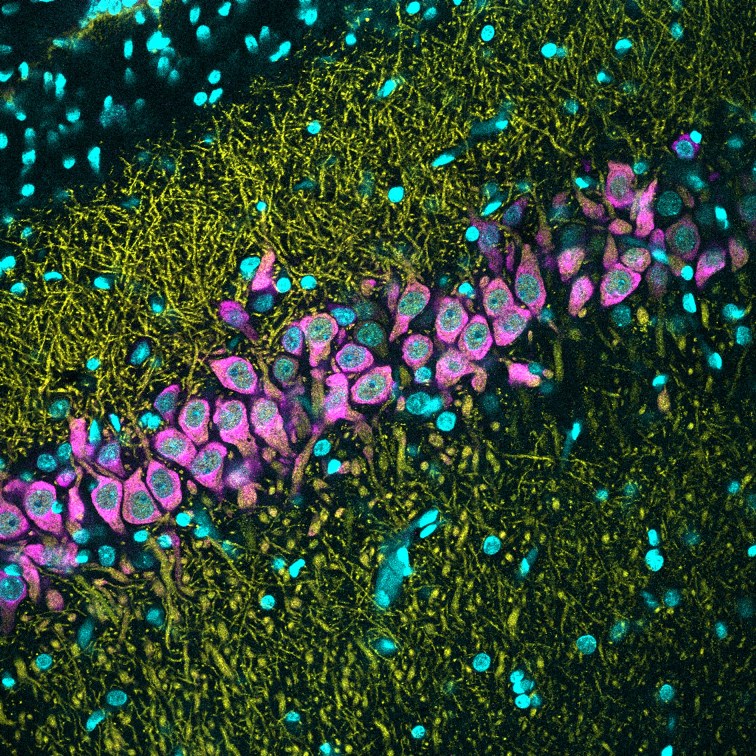
|
UNESCO issues the registration diplomas in the Memory of the World to the Archives of Santiago Ramón y Cajal, his brother Pedro, Pío del Río-Hortega and Fernando de Castro.
|
June 08, 2018
|
|
On past May 28th at the historic Paraninfo of the University of Salamanca, the Spanish Ministry of Education, Culture and Sports has delivered the diplomas accredited by UNESCO to the archives that make up the candidacy registered since December 1st, 2017 in the Memory of the World International Register (one of the programs that composes the World Heritage) as "Archives of Santiago Ramón y Cajal and the Spanish Neurohistological School".
This act of scientific and historical justice responds to an initiative launched in the summer of 2015 by the International Cajal Legacy Group, a group constituted on a personal basis by “Cajalian" neuroscientists from Spain and Australia under the presidency of Juan A. De Carlos (Instituto Cajal -CSIC), which barely found institutional support until finding D. Severiano Hernández, Assistant Secretary of State for State Archives (Spanish Ministry of Education, Culture and Sports).
The candidacy had the unanimous support of all the neuroscientific and neurological associations of the whole World, which had an impact on the Committee, not accustomed to receiving such solid proposals. The incontestable scientific discoveries made by Cajal and the most outstanding members of his School (Pío del Río-Hortega, Fernando de Castro, Pedro Ramón y Cajal -younger brother of the Maestro- and Rafael Lorente de Nó -diploma delivered in Mexico, directly, where this archive is conserved-) were fully received by the Selection Committee, adding these names to a very short list of scientists that also hosts the aforementioned program: Copernicus, Linnaeus, Newton, Darwin, Pasteur and Tesla.
The Cajal–CSIC Institute is pleased that five of its fundamental scientists now integrate this list that brings together, perhaps, the most influential scientists in all of history. The creation of a true, modern, active and ambitious Museum Cajal and of the Spanish Neurological School is now the goal that we must all mark ourselves. Great news for the whole of the Spanish scientific and cultural community, the Cajal Institute, the CSIC, the SENC, the FENS and all the "Neuroworld".
Find more information at:
hipertextual.com
tv.usal.es
www.unesco.org
And if you want to have access to the full video of the delivery ceremony:
tv.usal.es
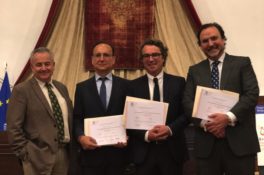
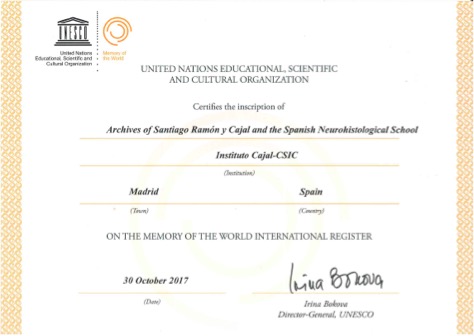
|
A new technique isolates neuronal activity during memory consolidation.
|
21 June, 2017
|
|
The lab of Liset M de la Prida from the Cajal Institute has discovered some basic processes underlying memory consolidation). The work, which is published in Neuron, identifies some of the electrical events responsible for specific neuronal activity in the hippocampus: a region of the brain with fundamental roles in episodic memory. Using artificial neural networks, researchers have been able to identify electrical fotprints associated to events with similar informational content, presumably encoding the same memory trace.
Liset Menéndez de la Prida laboratory
Link to the news in CSIC
Link to news on Neuron
|
The master in Neuroscience UAM-Cajal Institute has obtained the highest score at the University Autonoma of Madrid (UAM).
|
10 March, 2017
|
|
These are oficial results gathered by the Institutional Office of Studies and Evaluation from the student’s survey showing their satisfaction of the teachers of the different master programmes.
Excel Comparison Chart
|
Un trabajo dirigido por la Dra. Moratalla del Instituto Cajal del CSIC y del CIBERNED ha sido galardonado con el Primer Premio del XV Certamen Universitario Arquímedes, Primer Premio de la Fundación ONCE y Premio Especial como tutora del trabajo.
|
01 March, 2017
|
|
Un estudio dirigido por la Dra. Moratalla ha sido galardonado con el Primer Premio del área de biomedicina del XV Certamen Universitario Arquímedes, Primer Premio de la Fundación ONCE y Premio Especial como tutora del trabajo.
La dopamina es uno de los neurotransmisores más importantes del Sistema Nervioso Central. Se une a receptores específicos en las neuronas del estriado las cuales se encargan de modular el movimiento. Estas neuronas se dividen en dos tipos y actúan como el freno y acelerador de un coche.
Las neuronas de la vía directa facilitan el movimiento y las de la vía indirecta lo reprimen. El balance entre ambas, nos permite realizar movimientos coordinados. Utilizando un modelo genético de la enfermedad de Parkinson, el ratón Aphakia, los autores han demostrado que la falta de dopamina, que produce acinesia, disminuye la densidad de espinas y la longitud del árbol dendrítico en ambos tipos de neuronas.
La levodopa, tratamiento de elección en el Parkinson, alivia los síntomas motores pero el tratamiento prolongado con este fármaco produce discinesias, que son movimientos anormales involuntarios que terminan incapacitando a los pacientes.
Los investigadores han visto que durante las discinesias se normaliza la densidad de espinas dendríticas y la excitabilidad neuronal selectivamente en las neuronas de la vía indirecta, mientras que las neuronas de la vía directa permanecen alteradas.
Este desequilibrio de conectividad entre los dos tipos neuronales podría estar implicado en el desarrollo de las discinesias inducidas por el tratamiento crónico y pulsátil con levodopa.
Estos resultados obtenidos por Samuel Alberquilla, el Dr. García-Montes y la Dra. Suárez en el laboratorio de la Profesora Moratalla esclarecen los mecanismos de la plasticidad estructural y sináptica que subyacen a la enfermedad de Parkinson y a las discinesias inducidas por el tratamiento crónico con L-DOPA.
Este trabajo ha sido financiado por los Ministerios de Economía y Competitividad, Sanidad, Política Social e Igualdad SAF2016-78207-R, por CIBERNED ISCIII PCIN2015-098, CB06/05/0055, PI2015-2/02 del Gobierno de España y por la Secretaría de Ciencia, Tecnología e Innovación de la Ciudad de México (Convenio 065/2013).
|
A patent of the José María Frade’s research Group has been accepted in the United States of America.
|
10 February, 2017
|
|
The patent entitled " Phosphorylation on the Thr-248 and/or Thr-250 residues of transcription factor e2f4 as a therapeutic target in pathological processes associated with somatic polyploidy" has been issued by the United States Patent and Trademark Office. This patent is being exploited by Tetraneuron S.L., a spin-off of José María Frade’s research Group. This company has recently raised share capital.
|
The right hippocampus leads the bilateral integration of gamma-parsed lateralized information.
|
December 5, 2016
|
|
Dominance on one side prompts immediate synchronization of the two brain lobes to complete a scene.
Information in the hippocampus manifests as electrical activity in the form of pulses generated by a pacemaker on each side.

|
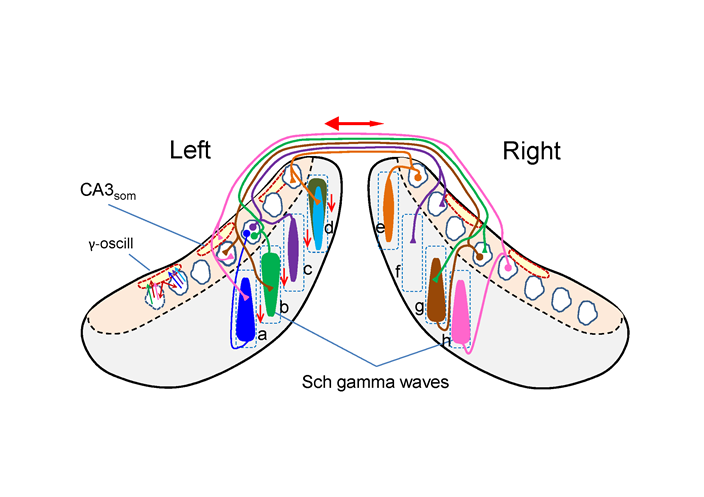 |
Symposium. History of Neuroscience: The dawn of the Spanish Neuroscience.
|
November 24th, 2016
|
|
Commissioned by the Federation of European
Neuroscience Associations (FENS) and the Spanish Society
for Neuroscience (SENC), we organized a one-day
symposium on “The dawn of the Spanish Neuroscience”, to
highlight the scientific excellence of Santiago Ramón y Cajal,
internationally known as the "father of modern
neuroscience". Cajal formed the “neurohistological school”,
which became well known and extended his work
worldwide, once the Master died.
Diptic of the symposium
Research Topic
|
Only one key aspect distinguishes the proteins that trigger Alzheimer's from those involved in memory consolidation.
|
January 27th, 2016
|
|
A study led by the Cajal Institute finds a crucial difference between "bad" and "good" amyloid protein aggregates.
The research could provide new targets for prevention, early diagnosis and treatment of neurodegenerative diseases.

|
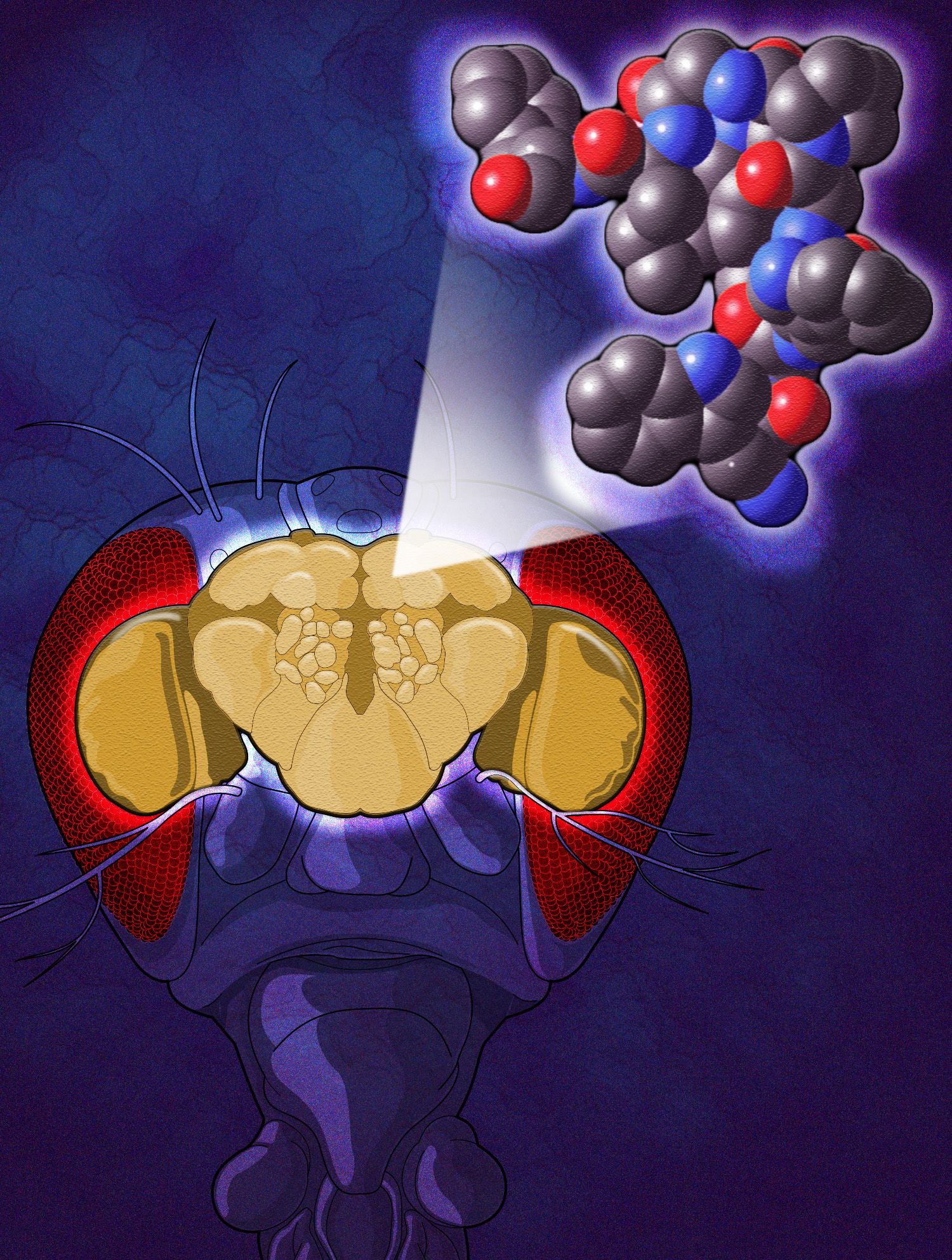 |
|
|
12-21-2015
|
|
The CajalXmas is a scientific and social meeting to bring together young and independent researchers from all over Spain and abroad to discuss and present their work in an informal environment during our traditional Christmas toast.

|
Special Topic in Olfaction. Almagro (Ciudad Real, Spain) 6-7 November 2015.
|
11-06-2015
|
|
Special Topic in Olfaction. Almagro (Ciudad Real, Spain) 6-7 November 2015. Organized by the Spanish Olfactory Network (ROE). This meeting is an initiative of the ROE aiming at celebrate biannually short conferences on selected topics on olfaction in enjoyable places . This year the selected topic is ADULT NEUROGENESIS to celebrate the 50th anniversary of its discovery
Schedule
Triptych
|
MUSEO CAJAL, CSIC: Noviembre 2015-Noviembre 2016, Exposición: “Santiago Ramón y Cajal Exhibition in the Porter Center”.
|
01-11-2015
|
|
Everyone working in the Porter Neuroscience Research Center is very grateful to the Instituto Cajal in Madrid, for the loan of seven original Cajal drawings—which have been a great source of inspiration over this past year.
Link to the news
|
MUSEO CAJAL, CSIC: 6 de octubre de 2015 al 16 de enero de 2016, Exposición: “Fisiología de los Sueños: Cajal, Tangui, Lorca, Dali, …”.
|
6-10-2015
|
|
La exposición, comisariada por el profesor de la Universidad Complutense de Madrid, Jaime Brihuega, propone un recorrido que parte de los dibujos histológicos del Premio Nobel Santiago Ranón y Cajal, y atraviesa las obras de reconocidos artistas vinculados con el Surrealismo nacional e internacional, estableciendo así un parentesco visual entre las formas analizadas a través del microscopio científico y el imaginario surrealista, tan cercano al mundo de los sueños.
Link to the news
Press release
Triptych exhibition
|
Functional heterogeneity of hippocampal pyramidal cells
|
September, 14
|
|
A team lead by Dr. Liset Menendez de la Prida has discovered that pyramidal cells from the hippocampus, the main brain structure responsible for memory formation , are less uniform than previously thought adopting an organization similar to the neocortex .

|
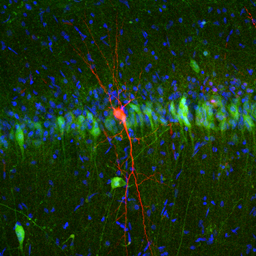 |
III Joint Yale-Cajal Meeting
|
October 6,7
|
|
October 6,7, III Joint Yale-Cajal Meeting.
James Rothman, Nobel Prize in Medicine 2013 will deliver the Keynote Lecture as part of the Yale faculty contributing to this third edition
Flyer
|
Current boundaries of the expanding landscape of insulin-like activities and beyond
|
September 24-26
|
|
September 24-26, Current boundaries of the expanding landscape of insulin-like activities and beyond.
A tripartite meeting of the Cajal Institute, Karolinska Institute and The University of Tokyo, sponsored by JSPS
Flyer
|
Fifth Cajal Diploma awarded to Prof. Pasko Rakic
|
04-09-2015
|
|
In the current edition, the "Cajal Diploma" will be awarded to Prof. Pasko Rakic. This award is given periodically to eminent neuroscientists, for their contribution to the knowledge of the Nervous System. To date, this prize had been awarded to Rita Levi-Montalcini, Erik Kandel, Anders Björklund, and Rodolfo Llinás. The award is sponsored by the "Clotilde Jiménez Legacy".
|
2015 Summer school on neurorehabilitation
|
02-17-2015
|
|
13-18 SEPTEMBER 2015, EL SALER (VALENCIA, SPAIN).
SSNR2015 will provide in depth education on advanced procedures for neurorehabilitation of motor dysfunction following stroke, SCI, CP and other neurological conditions, covering practical applications based on neuroprosthetics, robotics interfaces and other combinational and technological approaches. World-‐class experts in various related disciplines will deliver plenary talks and a set of hands-‐on workshops will be organized.
Flyer
http://WWW.SSNR2015.ORG
|
I WORKSHOP I2M2-NEUROSTEM-CM
|
12-19-2013
|
|
On 19 and 20 December 2013, the Neurostem consortium of Comunidad de Madrid which Dra Moratalla and Dr Carlos Vicario of Cajal Institute (CSIC) belongs, will be held a workshop with other consortium called: multimodal molecular image inflammation (I2M2). The event will be held on the 19th from 16.00 to 19.00h on the 20th from 10.00 to 13.00 in the Department of Pharmacology, Faculty of Medicine, University Complutense Madrid, and have the presence as guest of Dr Obeso.
Activities Program
|
A new model of episodic-like memory deficit in experimental TLE
|
6-11-2013
|
|
A recent work by the Prida group now reports on the neurophysiological correlates of episodic-like memory deficit in experimental TLE. The paper was published in The Journal of Neuroscience issue of Nov 6th 2013

|
On June 26th, the fourth Cajal Medal was awarded to Prof. Rodolfo Llinás in the presence of H.M. Queen Sofia
|
08-07-2013
|
|
In the current edition, the "Cajal Medal" will be awarded to Prof. Rodolfo Llinas. This award is given periodically to eminent neuroscientists for his contribution to the knowledge of the Nervous System.

|
 |
Researchers at the Cajal Institute demonstrate the presence of tetraploid neurons in the mouse brain, generated by means of a p75-dependent mechanism.
|
25-04-2013 |
A study recently published in The Journal of Neuroscience demonstrates that a subpopulation of long-range projection neurons contain double the normal amount of DNA in their nuclei. These tetraploid neurons remain functional in the adult mouse since they express immediate early genes activated in response to neuronal activity. This study, performed in the mouse cerebral cortex and striatum, demonstrates that the neurotrophin receptor p75 is expressed by the precursors of the projection neurons. The study provides genetic support for the participation of p75 in neuronal tetraploidization since mutant mice for the gene encoding this receptor show a significant reduction of tetraploid neurons.
López-Sánchez N y Frade JM (2013) Genetic evidence for p75NTR-dependent tetraploidy in cortical projection neurons from adult mice. J. Neurosci., 33: 7488-7500.
|
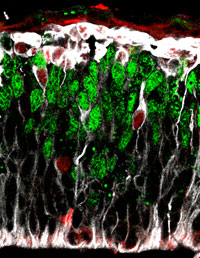 |
Advanced microprobes for simultaneous neural depth recording and drug delivery in the brain
|
10-4-2013 |
A multidisciplinary team including the national research council (CSIC), IKERLAN and the Instituto de Investigación en Ingeniería de Aragón, cooordinated by Liset menendez de la Prida from the Instituto Cajal have developed a novel generation of microprobes for simultaneous depth recording and drug delivery using exclusively the polymer SU-8 as structural material. The device was tested experimentally using the in vivo anesthetized rat preparation. Both probe types successfully recorded detailed spatiotemporal features of local field potentials and single-cell activity at a resolution never attained before with integrated fluidic probes. Drug delivery was achieved with high spatial and temporal precision in a range from tens of nanoliters to a few microliters, as confirmed histologically. |
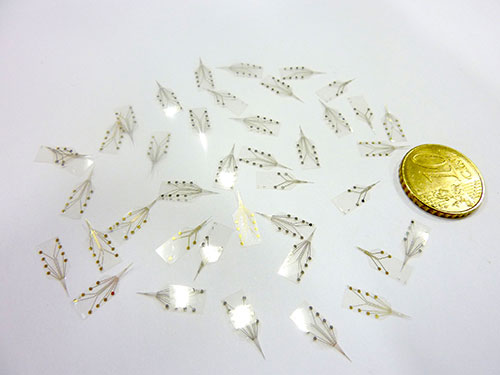 |
These technological advancements will foster a wide range of neural applications aimed at simultaneous monitoring of brain activity and delivery at a very precise micrometer scale.
Ane Altuna, Elisa Bellistri, Elena Cid, Paloma Aivar, Beatriz Gal, Javier Berganzo, Gemma Gabriel, Anton Guimerà, Rosa Villa, Luis J. Fernández y Liset Menéndez de la Prida. SU-8 based microprobes for simultaneous neural depth recording and drug delivery in the brain. Lab on a chip. DOI: 10.1039/c3lc41364k. |
Signing of an R&D contract to verify a possible therapeutic approach against Alzheimer's disease |
29-11-2012 |
The CSIC has signed an R&D contract with the biotechnology company Tetraneuron for the development of agents able to block neuronal tetraploidization...
 |
La fórmula de las decisiones en grupo
(Spanish) |
27-11-2012 |
Un individuo aislado se basa en la información que le rodea y en sus experiencias previas para tomar una decisión. No obstante, dentro de un colectivo, esta opción está influenciada por las decisiones individuales que elije cada miembro del grupo. Una investigación del Consejo Superior de Investigaciones Científicas (CSIC) ha desarrollado una fórmula matemática que refleja la probabilidad de escoger una u otra opción dentro de un grupo de la misma especie. Dicha fórmula apareció recogida ayer en la revista Proceedings of the National Academy of Sciences (PNAS).

|
|
See all |